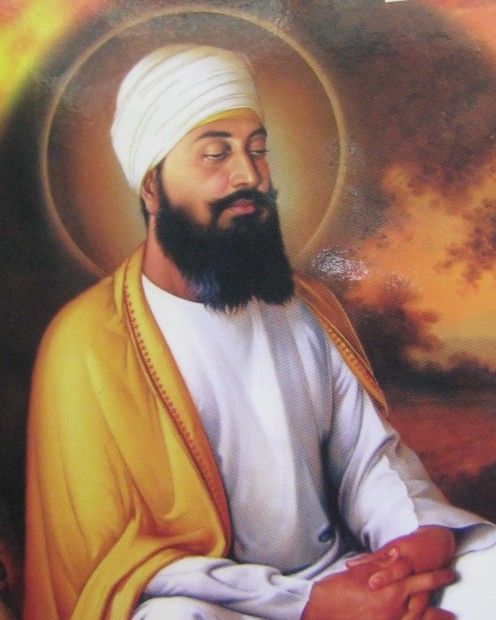Guru Tegh Bahadur

| Predecessor | Guru Hari Krishen |
| Birth place | Amritsar |
| Successor | Guru Gobind Singh |
| Date of death | 11 November 1625 |
| Son | Gobind Rai |
| Death place | Gurudwara Sisganj , Chandini Chowk, Delhi |
| Mother | Mata Nanaki |
| Spouse | Mata Gujari |
| Father | Guru Hargobind Ji |
| Date of birth | 1 April 1621 |
| Original Name | Tyag Mal |
Hind di Chadar : Guru Tegh Bahadur
The Back Story
The Balguru Hari Krishen died of Smallpox while in captivity of Mughals at Delhi. Before he died he indicated to the people around him that the next guru would be Baba Bakale, an old man living in the village of Bakala . The news spread and a lot of claimants announced themselves as the Guru. To sort this chaos , a wealthy trader Baba Makhan Shah came forward. He had once prayed for his life and promised to gift 500 gold coins to the Guru. He went to every claimant and offered them two gold coins knowing that the true Guru would be aware of the promise he made. When he went to Tegh Bahadur , he offered him two gold coins which Tegh Bahadur accepted, remarking that the promise was of 500 gold coins . Excited by this , Makhan Shah went on the rooftop and began shouting , Guru Ladho re, Guru Ladho re( the guru has been found ) and with this incident Tegh Bahadur was instated as Guru Tegh Bahadur, the ninth Sikh guru. He was born as Tyag Mal to Guru Hargobind Singh ji he was renamed Tegh Bahadur ( the mighty sword wielder) by his father , Guru Hargobind Ji, after he showed exemplary military brilliance against the Mughals in the Battle of Kartarpur. Guru Tegh Bahadur lived the life of a mendicant and devoted most of his time to meditation. [ref]
Travels of India
He worked extensively to strengthen the Sikh Panth across the country. He was gifted a piece of land by Rani Champa of Bilaspur which he bought for 500 rupees and established the city of Anandpur Sahib, the haven of bliss, at the foothills of Himalaya. He roamed extensively in regions of UP, Bihar , Bengal , Assam and Bangladesh spreading the words of Nanak. He lived in Assam for three years and helped end the war between Raja Ram Singh of Bengal and Raja Chakardhwaj of Ahoms .
The Tensions in Punjab
He returned to Punjab in 1670, midst of tension and chaos. Hindus and Sikhs of Punjab were dreaded by the religious persecution policy of Aurangzeb and saw Guru Sahib as their last hope to save their faith. Temples were demolished , forcible conversions were made and taxes were reimposed on Hindu and Sikh places of worship. Tegh Bahadur took an extensive tour of Punjab and wherever he went he attracted great crowds and was given handsome donations by his admirers. The Kashmiri Pandits dreaded by Aurangzeb reached to the guru and asked for protection from Mughal. It was now clear that a holy man will have to lay down his life to intercede and the question was who this man will be. Hearing the serious nature of the conversation, Guru Jis 9 year old son Gobind Rai Ji responded to his father Who would be better than you to defend the poor Brahmins?. Guru Tegh Bahadur smiled and resolved to stand up for the faith of millions , standup for the cause of humanity. It was then declared to Aurangzeb that if he could convert Guru Tegh Bahadur Ji, the Kashmiri pandits and other Sikhs would gladly convert to Islam too. [ref]
Execution in Delhi
After this the Guru and his disciples were arrested and taken to Delhi where the emperor and the qazis played a lot of tactics but all in vain. The emperor ordered the execution of Guru and his disciples in 1675. He did all cruelties to break the resolve of Guru Sahib ji. Three of his disciples were executed in front of him in the most heinous ways. One was burnt alive, another sawn into two and third put into boiling oil but all this also could not break the faith and resolve of the Guru. He was then beheaded on the order of the Qazi, after he refused to show any miracle to them. [ref]
Cremation
Before his body could be displayed to the public it was taken away in the cover of darkness by his disciples. The body was cremated at RakabGanj a village in vicinity of Red fort by a disciple who kept the body in his house and set his hut on fire. His head was taken to Anandpur Sahib and was cremated by his son Gobind Rai Ji.
Legacy
Today, the Gurdwara Sis Ganj Sahib in Chandni Chowk, Delhi, is built over where the Guru was beheaded and Gurdwara Rakab Ganj Sahib, located in Central Delhi is the site where a disciple burnt his house to cremate his master's body. Another gurdwara with the name of Sisganj Sahib in Anandpur Sahib ,Punjab, marks the site where the head of the martyred Guru Teg Bahadur Sahib ji was cremated by Gobind Rai, the one who led the destiny of community after Guru Tegh Bahadur. And with this the Guru became Hind di Chadar , the saviour of faith and freedom. The most reliable source of information about this martyrdom is the Bicitra Natak composed by Guru Gobind Singh ji , who writes :
To protect their right to wear their caste marks and sacred threads, Did he, in the dark age , perform the supreme sacrifice. To help the saintly he went to the utmost limit, He gave his head but never cried in pain. He suffered martyrdom for the sake of his faith. He lost his head but revealed not his secret.
